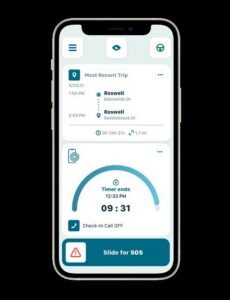Since the 1980’s, the UK has seen considerable change in relation to driver technologies and practices, whether by introduction of and greater reliance upon telematics and ‘black box’ systems, to more recently the use of semi-autonomous and self-braking vehicles. Innovation and tech certainly appear to be creating a shift change, in terms of how duty holders and organisations are seeking to manage and control its work-related road risk (“WRRR”).

The Law
Importantly, the legal framework surrounding ‘on-the-road’ work activities and health and safety (“H&S”) has not changed. Since 1974, employers have had to pro-actively ensure the health, safety and welfare of its employees at work and non-employees, so far as is reasonably practicable. ‘So far as reasonably practicable’ means balancing the level of risk against money, time or resource needed to implement measures that the eliminate or control the risk. This applies to WRRR activities in the same way, as well as any other work-related activity.
Notably, what is ‘reasonably practicable’ can change. As understanding of a risk increases, the ways in which risk can be managed improves and the costs to do so decrease, what may have been considered impracticable 10 years ago now becomes possible. Employers are duty bound to regularly review their policies and procedures to ensure control measures remain adequate, and where necessary can take account of relevant advances in technology and practices.
Yet the number of work-related deaths in the UK involving moving vehicles, remain the second highest reported by the Health and Safety Executive (HSE) in their most recently published statistics. More than a quarter of all road traffic incidents also involve somebody driving as part of their work (published Department for Transport (“DfT”) figures.) Therefore, this begs the question: are the modern-day advancements in driving/driver safety working? Do they have a place in 2021 and beyond?
The analysis from, Emma Evans, Glen Ridgway, Jon Cowlan, Dr Jim Golby, below, seeks to consider these questions in more detail.
Relevant Guidance
In 2014, the HSE and DfT issued joint guidance ‘INDG 382: Driving for Work’ to help duty holders manage WRRR. INDG 382 has, for several years served as a useful aid to employers whose employees drive for work (including ‘grey fleet’ users) and those who are responsible for overall fleet management.
Positive compliance with INDG382 would help demonstrate an employer has discharged their legal obligations pursuant to Health and Safety at Work etc. Act 1974 (HSWA), as well as the Management of Health and Safety at Work Regulations 1999 (MHSWR). INDG 382 encourages the ‘Plan, Do Check, Act’ approach to managing WRRR (the same as for other H&S risks).
Unfortunately, there are some fundamental issues in still applying this approach. These include:
- A failure to recognise that driving is a key ‘work-related’ risk, or to recognise that an ‘at work journey’ is defined as ANY journey for business that is not to and from a normal place of work (be this driving from London to Glasgow or just popping down to the post office);
- A failure to consider ‘human factors’ such as driver attitude, organisational culture, time pressures etc. when developing plans;
- Inadequate resources to ensure that any plans that are in place are properly established;
- Inadequate resources to monitor whether policies and procedures are being followed and having a positive benefit on driver safety;
- A failure to keep up to date with changes in technology and innovation that may improve the safety of their drivers.
Risk… what risks?
Some of the changes initially brought about by the pandemic are likely to continue, at least to some extent, in our ‘future world of work’. These include, amongst others: drivers being recognised as vital ‘key workers’, relaxations of drivers hours, as well as more people likely to travel by their own means/vehicles as opposed to public transport etc. As a result, several challenges and ‘key’ risk factors remain:
Increased use of ‘Grey Fleet’
Employees who use their own vehicle for work journeys present several issues for employers. In addition to ensuring that the individual is legally entitled to drive and has the correct insurance to allow them to do so for work, an employer needs to reasonably ensure as part of its legal obligations, that the vehicle driven is safe, roadworthy, taxed and appropriate for the task being undertaken (e.g., carrying goods or equipment)
Driver ability should also be checked to some extent. It is likely that there will be many new drivers on company business. Do they have the right attitude as well as aptitude? Under HSWA, employers have a duty of care to their drivers, but also to other people and road users who may be affected by them. Therefore, employers should consider driver training (on-line or in vehicle) as a minimum if they allow employees to use their own vehicle (or any vehicle used for work).
In addition, new technology is emerging that can monitor driver styles and provide immediate (post journey) feedback on how to improve. Remember, drivers work for you, but also represent you! Poor driver behaviour may impact on your reputation, costing you time and money.
The HSE, working in partnership with the DfT, recently published updated guidance on work-related road risk (WRRR) for employers and workers. The gig economy and the increasing use of personal vehicles for work purposes – the so-called ‘grey fleet’ – has created some confusion over where responsibility for legal compliance lies, says the regulator.
HM Inspector for HSE’s Transport and Public Services Unit, Nicola Jaynes, commented: “Companies who otherwise have robust health and safety policies sometimes fail to consider their responsibilities adequately when it comes to driving or riding for work. Everyone should come home from work safe and well, whether they’re working behind a desk or behind the wheel.”
Speeding
 Most drivers openly admit that they regularly exceed the speed limit with reasons quoted as being “They were in a hurry”, “They generally enjoy driving fast” or “They were bored”. But exceeding the posted speed limit is only part of the problem!
Most drivers openly admit that they regularly exceed the speed limit with reasons quoted as being “They were in a hurry”, “They generally enjoy driving fast” or “They were bored”. But exceeding the posted speed limit is only part of the problem!
A DfT report in 2016 highlighted that in the UK during 2015, 217 people were killed in crashes involving someone exceeding the speed limit but a further 132 people died when someone was travelling too fast for the conditions (for example, in poor weather, poor visibility or high pedestrian activity).
Increasing driver awareness and driver training are essential tools for managing this risk, but so is journey planning. Giving drivers adequate time (including rest periods) to travel between destinations so they are not tempted to speed, ensuring that they take weather conditions into account and giving them permission to be late, rather than putting themselves and other at risk should be fundamental parts of any driver safety culture.
Lone Working
The HSE defines Lone Workers as “those who work by themselves without close or direct supervision”. This includes drivers and users of public transport. So, as the number of drivers increase, the more employers may need to manage ‘lone worker’ risks to them as or when they arise, in a way that they may not have had to consider this way before. For example, employee’s now travelling alone between sites / different workplaces, at more unsocialable hours or to remote locations, rather than on public transport or by other means.
Some of the current ways to manage Lone Working may include updating process and procedures to include a buddy system, regular check-ins, sign-on/sign-off protocols etc. Whilst these can help, they rely heavily on people adopting them as routine practice, and unfortunately people make mistakes and reliance on human input is not infallible. Another key problem is that it is reactive, only coming into effect when the protocol is triggered, which could be several hours after an incident.
Several technical solutions such as fobs that employees carry, or Apps on their phones have been developed in recent years, including GPS location, ‘panic buttons’, man down (that detect when somebody falls) and reminder functions to name a few.
Fatigue
Fatigue is a silent killer. Driving when tired significantly affects attention, alertness and reaction times. It can reduce the driver’s ability to assess risks and can lead to poor decision-making while on the road. In the worst cases drivers may fall asleep at the wheel. Studies across the world suggest that driver fatigue is a factor in as many as 20% of all accidents and a quarter of all driver deaths.
A recent H&S prosecution resulted in £450k financial penalty against a company with clear failures in respect of fatigue management.[1]
The DfT has also recently extended the temporary relaxation of the enforcement of the retained EU drivers’ hours rules in England, Scotland and Wales[2], due to the continued pressures on local and national supply chains. This relaxation is in place until 3 October 2021. This is considered by some as controversial, as it may encourage or permit longer driving periods overall, particularly when hauliers and HGV drivers have already worked extremely long hours throughout the pandemic.
It is possible to develop procedures to highlight fatigue risk, and recognise, monitor, manage and mitigate it. But without considering the individual’s attitudes, personal circumstances, and choices, surely they can only go so far. How do employers influence their people to recognise that their choices outside of work can put themselves and others at risk when working? This will likely take a significant investment in time and effort to change attitudes and perhaps, the overall culture of the organisation.
However, alongside behavioural safety or cultural change programmes, technologies now exist that are programmed to detect signs that a driver may be fatigued and alert them, so they can take corrective action at source.
Look Ahead: 2021 and beyond
 A recent consultation by HSE into INDG382, considered issues including what were the main distractions for drivers were whilst driving; what guidance duty holders currently use to help manage WRRR; what format would duty holders like to see guidance in the future (including options for digital content, websites, videos etc); what methods duty holders use to manage WRRR as well as trying to understand some of the barriers to managing WRRR. The latter includes employee attitude, financial pressure, culture and time pressure, for example.
A recent consultation by HSE into INDG382, considered issues including what were the main distractions for drivers were whilst driving; what guidance duty holders currently use to help manage WRRR; what format would duty holders like to see guidance in the future (including options for digital content, websites, videos etc); what methods duty holders use to manage WRRR as well as trying to understand some of the barriers to managing WRRR. The latter includes employee attitude, financial pressure, culture and time pressure, for example.
In addition, a report into vehicle technologies carried out by HSE and TRL[3] (to assist with the update of INDG382) highlighted that good procurement is a key part of ensuring that the telematics system or technology to be used is a good fit for the business needs; organisations that contract drivers through a ‘gig economy’ model will still need to review the safety impacts of the technology through which they manage the distribution of work; and whilst now under consideration, a recommendation made to include “The Use of Vehicle Safety Monitoring Technology to Manage Risk” within the existing INDG 382.
This recommendation reinforces the use of technologies to help positively manage WRRR, including indicators of risky driver behaviours (e.g., excessive speed, harsh or erratic driving, distraction and drowsy driving). It also suggests several things ought to be considered carefully, such as: out puts from the system, how management and coaching feedback is recognised as ‘critical’, and reinforces that technology is not always a replacement for clear, robust, documented and communicated policies.
So, is technology part of the answer…?
WRRR can be often seen as too complex and expensive, or something that is an ‘insurable risk’ (but notably, H&S or regulatory, criminal fines relating to WRRR would not be covered by insurance), or perhaps WRRR is not approached with the same vigour as other high-risk work activities, particularly as ‘driver error’ often takes primacy over potential organisational failures.
Another recent prosecution highlighted it is very much not just a ‘driver issue’ when the director of a haulage firm, RM Group, was sentenced in June 2021 to 15-years imprisonment following his conviction for two counts of Gross Negligence Manslaughter. This arose out of a crash on the M62 in April 2018, and a 31 tonne Scania truck belonging to RM Group lost control, jack-knifed, crossed onto the opposite side of the carriageway and collided with an oncoming motorist.
The root cause of this was defective brakes on the HGV which had been present for a prolonged period. Whilst the driver himself pleaded guilty to two counts of Causing Death by Dangerous Driving under the Road Traffic Act 1988, the Director of the company also found himself prosecuted and held liable for directing that the long-distance delivery should continue, even though adequate vehicle maintenance had not been carried out.
Therefore, innovation and technology would appear to make this seemingly complex issue more straight forward and can help assist drivers and employers together to ensure better standards of safety on the nation’s roads.
 An example of this is ‘Applied Companion’ from Applied Driving Techniques.
An example of this is ‘Applied Companion’ from Applied Driving Techniques.
‘Applied Companion’ is an automated, multi-functional app that uses AI-technology to constantly scan for potential driving events, at the same time as analysing driving performance to provide near real-time feedback and training prompts.
It constantly monitors driving performance, looking for ‘at risk’ events such as harsh acceleration and braking which are then flagged to the driver in real time so they can alter their driving style accordingly. It also recognises changes in driver behaviour which may indicate increasing fatigue or impairment. A crash detection function linked to a 24/7 third-party emergency call centre allows for immediate emergency response.
Experience suggests that the use of an app is more acceptable to drivers than the use of telematics especially in relation to grey fleet and non-commercial drivers.
Applied Companion is also useful for managing lone worker risks along with functions that offer support and protection and can trigger an immediate call back and emergency response (within 5 seconds) if required.
The automated nature of Applied Companion has the additional benefit of removing the burden of administration from already busy managers and provides them with the assurance that their drivers are being looked after.
TRL’s report highlighted over reliance on tech and gathering of data, however, will not always provide evidence of your legal duties being met or afford an arguable defence in law. Any critical or fatal, near fatal or seriously injured accidents (or near misses) should be analysed with the driver as soon as possible, whereas general driving information or data be considered on a regular basis, at suitable intervals (whether weekly or monthly analysis) as part of an organisation’s overarching monitoring arrangements aimed at identifying and managing emerging trends as and when they happen.
Conclusion
Technology is developing at a rate that means what was not reasonably practicable 10-years ago is becoming ever the more possible, at a cost that is affordable. This, combined now with a greater awareness by responsible businesses who view WRRR with as much importance as other safety issues and more than ever, want to implement and ensure robust ‘driving at work’ policies, means there is no longer any excuse for employers to not be effectively managing WRRR.
To help organisations deal with this complex area, ADT and Pinsent Masons have developed a combined offering which includes on-line training modules, Applied Companion, policy audit / review and fleet management software. All packages can be tailored to suit your organisation’s specific needs.

Emma Evans is a Senior Associate at Pinsent Masons, advising and defending organisations on specialist regulatory issues, including health and safety, fire safety, coronial law, transport law and related criminal litigation. She is experienced in advising various high hazard industries and holds the NEBOSH General Certificate in Occupational Health and Safety qualification.
Emma is adept at advising on a non-contentious basis and providing a variety of H&S advice and support, in relation to such as fleet / WRRR, Road Traffic Act prosecutions, as well as Hand Arm Vibration Syndrome, CDM, RIDDOR reporting, Employers Liability for H&S, and Directors Duties.
 Glen Ridgway is an independent workplace wellbeing consultant working with ADT on understanding how driver wellbeing impacts driver safety and Work-Related Road Risk.
Glen Ridgway is an independent workplace wellbeing consultant working with ADT on understanding how driver wellbeing impacts driver safety and Work-Related Road Risk.
He is NEBOSH Certified with over 10 years’ experience in workplace mental health and wellbeing developing and implementing strategies across multiple industries and clients. In his previous employment he introduced an award winning WRRR programme which reduced driver related accidents by nearly 80% in just two years.
 Jon Cowlan is a Health & Safety Consultant in the Regulatory Team and is a primary contact for Pinsent Masons’ preventive health & safety services. His experience encompasses strategic safety management, training, due diligence, CDM/construction, project safety and accident investigation.
Jon Cowlan is a Health & Safety Consultant in the Regulatory Team and is a primary contact for Pinsent Masons’ preventive health & safety services. His experience encompasses strategic safety management, training, due diligence, CDM/construction, project safety and accident investigation.
He has Board level experience in the construction, projects and programme management fields. He is a Chartered Fellow of the Institution of Occupational Safety & Health, a Fellow of the Royal Society for Public Health and a graduate chemical engineer.
Jon is also a National Examination Board in Occupational Safety & Health (NEBOSH) Diploma exam marker for national and international papers in law & risk management.
 Dr Jim Golby PhD FCIPD is the Chair of the multi-award-winning Driver Risk and Accident Management Consultancy Applied Driving Techniques (ADT) which currently protects over 200,000 drivers in over 50 Countries around the Globe.
Dr Jim Golby PhD FCIPD is the Chair of the multi-award-winning Driver Risk and Accident Management Consultancy Applied Driving Techniques (ADT) which currently protects over 200,000 drivers in over 50 Countries around the Globe.
Jim is a member of the European Transport Safety Council’s Expert Panel, former CIPD and Brake Award Winner and Chair of several Industry Groups. He has been closely involved with Work Related Road Risk (WRRR) since 2004.
Since joining ADT in 2011 Jim has worked closely with a multitude of prestigious organisation across all Industry Sectors delivering a typical reduction in incidents of 30-40% in the first 12mts alone.
[1] Renown Consultants Limited in 2020 – Contractor Renown Consultants fined £450k | Office of Rail and Road
[2] Article 14(1) of the retained EU Drivers Hours Regulations
[3] TRL Report
The Safety Conversation Podcast: Listen now!
The Safety Conversation with SHP (previously the Safety and Health Podcast) aims to bring you the latest news, insights and legislation updates in the form of interviews, discussions and panel debates from leading figures within the profession.
Find us on Apple Podcasts, Spotify and Google Podcasts, subscribe and join the conversation today!


 Most drivers openly admit that they regularly exceed the speed limit with reasons quoted as being “They were in a hurry”, “They generally enjoy driving fast” or “They were bored”. But exceeding the posted speed limit is only part of the problem!
Most drivers openly admit that they regularly exceed the speed limit with reasons quoted as being “They were in a hurry”, “They generally enjoy driving fast” or “They were bored”. But exceeding the posted speed limit is only part of the problem! A recent consultation by HSE into INDG382, considered issues including what were the main distractions for drivers were whilst driving; what guidance duty holders currently use to help manage WRRR; what format would duty holders like to see guidance in the future (including options for digital content, websites, videos etc); what methods duty holders use to manage WRRR as well as trying to understand some of the barriers to managing WRRR. The latter includes employee attitude, financial pressure, culture and time pressure, for example.
A recent consultation by HSE into INDG382, considered issues including what were the main distractions for drivers were whilst driving; what guidance duty holders currently use to help manage WRRR; what format would duty holders like to see guidance in the future (including options for digital content, websites, videos etc); what methods duty holders use to manage WRRR as well as trying to understand some of the barriers to managing WRRR. The latter includes employee attitude, financial pressure, culture and time pressure, for example. An example of this is ‘Applied Companion’ from Applied Driving Techniques.
An example of this is ‘Applied Companion’ from Applied Driving Techniques.
 Glen Ridgway is an independent workplace wellbeing consultant working with ADT on understanding how driver wellbeing impacts driver safety and Work-Related Road Risk.
Glen Ridgway is an independent workplace wellbeing consultant working with ADT on understanding how driver wellbeing impacts driver safety and Work-Related Road Risk. Jon Cowlan is a Health & Safety Consultant in the Regulatory Team and is a primary contact for Pinsent Masons’ preventive health & safety services. His experience encompasses strategic safety management, training, due diligence, CDM/construction, project safety and accident investigation.
Jon Cowlan is a Health & Safety Consultant in the Regulatory Team and is a primary contact for Pinsent Masons’ preventive health & safety services. His experience encompasses strategic safety management, training, due diligence, CDM/construction, project safety and accident investigation. Dr Jim Golby PhD FCIPD is the Chair of the multi-award-winning Driver Risk and Accident Management Consultancy Applied Driving Techniques (ADT) which currently protects over 200,000 drivers in over 50 Countries around the Globe.
Dr Jim Golby PhD FCIPD is the Chair of the multi-award-winning Driver Risk and Accident Management Consultancy Applied Driving Techniques (ADT) which currently protects over 200,000 drivers in over 50 Countries around the Globe.